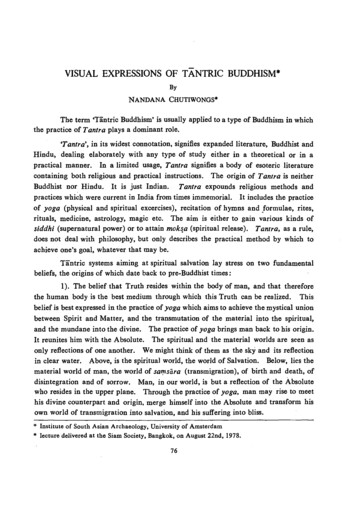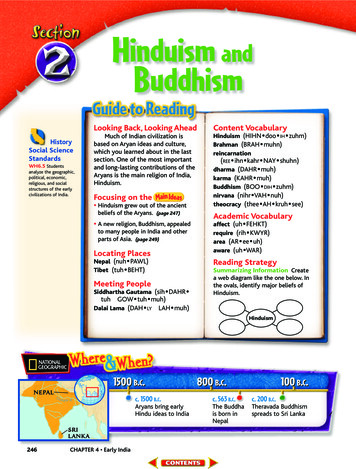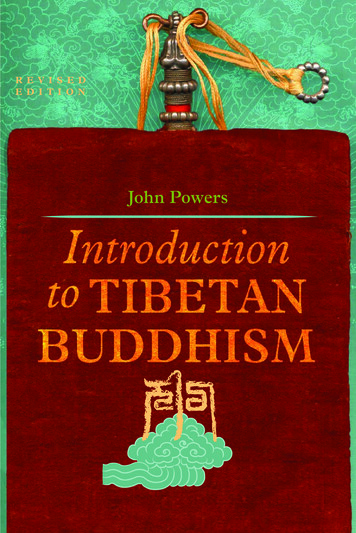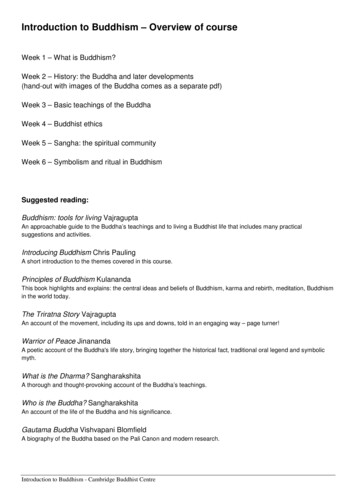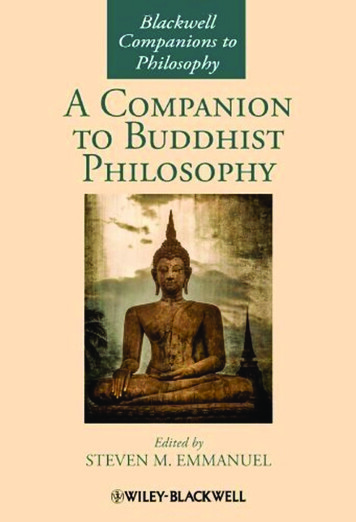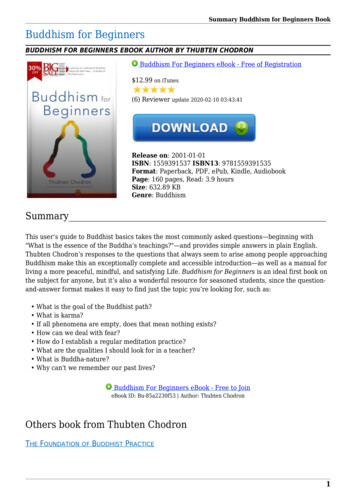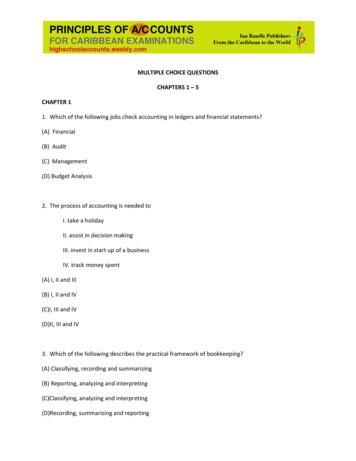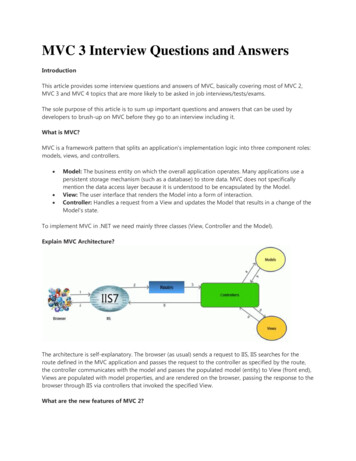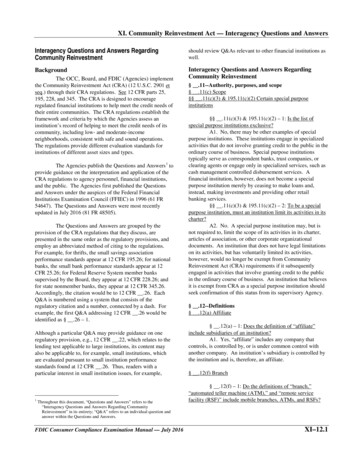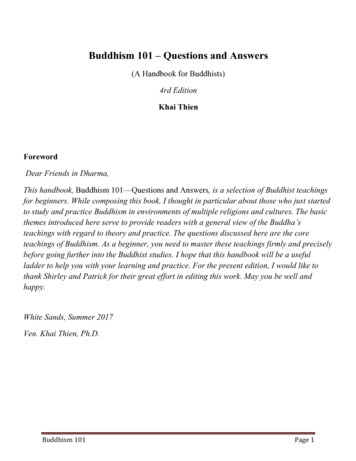
Transcription
Buddhism 101 – Questions and Answers(A Handbook for Buddhists)4rd EditionKhai ThienForewordDear Friends in Dharma,This handbook, Buddhism 101—Questions and Answers, is a selection of Buddhist teachingsfor beginners. While composing this book, I thought in particular about those who just startedto study and practice Buddhism in environments of multiple religions and cultures. The basicthemes introduced here serve to provide readers with a general view of the Buddha’steachings with regard to theory and practice. The questions discussed here are the coreteachings of Buddhism. As a beginner, you need to master these teachings firmly and preciselybefore going further into the Buddhist studies. I hope that this handbook will be a usefulladder to help you with your learning and practice. For the present edition, I would like tothank Shirley and Patrick for their great effort in editing this work. May you be well andhappy.White Sands, Summer 2017Ven. Khai Thien, Ph.D.Buddhism 101Page 1
101 – Questions and Answers1.What does Buddhism have in common with other religions?2.How does Buddhism differ from other religions?3.Briefly, who was the Buddha?4.How is Buddhism defined?5.Does Buddhism ask us to reject the world?6.Is Buddhism a religion or philosophy?7.What is the main principle of Buddhism?8. If Buddhism is a non-theistic religion, can we say that it is a religion of science or one ofphilosophy?9.What happened in the history of Buddhism to change it from its original form?10. Since its beginning, how has Buddhism changed over time?11. In addition to the two forms of Buddhism—original and developed—why do we also havethe names Southern Buddhism and Northern Buddhism?12. How do Southern Buddhism and Northern Buddhism differ in practice?13. How do Southern Buddhism and Northern Buddhism differ with regard to enlightenment?14. What are the ten stages of Mahāyāna Bodhisattva development?15. What is the difference between Southern Buddhism and Northern Buddhism with regard tothe ideal model?16. How many major systems of philosophy exist in Buddhism?17. What are the fundamental beliefs in Buddhism?18. What is the karmic law of cause and effect?19. What are the three karmas?20. In Buddhism, what is Samsāra and how does it work?21. If Buddhism does not believe in an immortal soul, then what and who will be reborn in theBuddhism 101Page 2
cycle of samsāra?22. How can one know that he or she will be reborn in the cycle of samsāra?23. How are the Buddhist mental formations such as the concepts of mind, thought andconsciousness different?24. If God does not exist, then on what condition is the existence of heaven and hell based?25. If everything comes from the mind, how can a non-Buddhist practice the Buddhistdoctrine?26. What is the primary core of spiritual practice in Buddhism?27. Is there any difference in the manner of practice of Buddhism and that of other religions?28. Does one benefit if he only practices one of the three pure studies: moral discipline,meditation, or wisdom?29. How can a person become a Buddhist?30. Why must a person take refuge in the Triple Jewels to become a Buddhist?31. Can a person attain enlightenment and liberation if he just practices the Dharma withouttaking refuge?32. Is the moral discipline of Buddhism similar to or different from that of other religions?33. What are the four all-embracing virtues (Catuh-samgraha-vastu)?34. What are the deeds of pāramita (transcendental perfection)?35. What is the Bodhi mind (Bodhicitta)?36. What are the four foundations of mindfulness?37. What are the four right efforts (catvāri prahāṇāni)?38. What are the four supernatural powers (rddhipāda)?39. What are the five spiritual faculties (pañcānām indriyāṇām) and their five powers(pañcānāṃ balānām)?40. What are the seven branches of enlightenment (saptabodhyanga)?Buddhism 101Page 3
41. What is the noble eightfold path?42. Is there any plain and simple teaching that can be remembered most easily?43. Why do we eat vegetarian foods?44. Can a person become a Buddha by eating purely vegetarian foods, and how isvegetarianism related to spiritual practice?45. Does a Buddhist break the precept of not killing when he eats meat?46. What does repentance (Ksamayati) mean in Buddhist rites?47. Can a person’s unwholesome karmas be eradicated through repentance?48. What is the aim of reciting the Buddhas’ names?49. Would you please explain more about the doctrine of Pure Land School (Sukhāvati) andthe practice of reciting the Buddhas’ names?50. What is the core teaching of the Pure Land School?51. What is meditation?52. How is Ānāpānasati meditation related to vipassanā meditation?53. What are the main themes of both Ānāpānasati and vipassanā meditation?54. Regarding the breaths and breathing, how important are they in the practice ofmeditation?55. Would you please explain more about the role and function of the one-pointed mind inmeditation?56. How do feelings relate to the mind?57. Would you please explain more about insight meditation?58. Why does a practitioner have to mediate on the body in such detail?59. What are the five aggregates?60. Why are the five aggregates considered the foundation for the twelve senses-bases andeighteen psychophysical domains?Buddhism 101Page 4
61. Why are aggregates, senses-bases, and psychophysical domains analyzed in such detail?62. Would you please explain the nature of the self or ego in the Buddhist view?63. If there is no individual self or personal ego, who will suffer and who will be happy?64. What is non-self?65. Does the reality of the non-self relate to nirvāna?66. How can one perceive the meaning of emptiness (śūnyatā) in the presence of things?67. Why is it said that the middle way is the path leading to nirvāna?68. How can we apply the teaching of the middle way to practical life?69. Would you please explain more about the two truths?70. Is the absolute truth identical to the realm of nirvāna?71. Would you please explain more about the characteristics of nirvāna?72. Why does a Buddhist expression say that “samsāra is nirvāna”?73. What does nirvāna relate to in the doctrine of three Dharma Seals?74. How can an ordinary person live a life of non-self?75. How should a selfish and egocentric person practice the Dharma?76. Would you please explain the concept of “merit” in Buddhism?77. What is the characteristic of ‘pure merit’ and that of ‘impure merit’?78. What is the Buddhist view on the issue of “good and evil”?79. Why are there different viewpoints on the issue of “good and evil”?80. What is ignorance in the Buddhist view and is a wise person like a scientist still ignorant?81. How should a person of weighty ignorance practice the Dharma?82. How should a person of weighty hatred (ill will) practice the Dharma?83. How should a person of weighty craving practice the Dharma?Buddhism 101Page 5
84. How does the Buddhist concept of happiness differ from the mundane concept ofhappiness?85. What is the true career of a Buddhist?86. Do different methods of spiritual practice oppose one another?87. Is there any difference in the methods of practice for young and old persons?88. How should an aged person practice the Dharma, particularly when his or her time of lifeis shortened?89. Why should a person be aware of the future life if he or she practices being in the present?90. How should young people practice the Dharma?91. How should a person who is experiencing much illness or who is near death practiceDharma?92. What should one do in order to extinguish his or her fear of death?93. Loneliness is an obsession of a person when facing old age and death. How should onepractice Dharma in order to overcome this obsession?94. How can a person overcome this obsession of old age and death if he or she is unable toappreciate the taste of inner tranquility?95. How should we encourage our younger children to practice the Dharma?96. How can we live in harmony with a person who follows other religions in the same family?97. How should we live in harmony with a person of divergent views?98. How can we live in harmony with a person who embraces the wrong views?99. How can one live peacefully with or alongside a person who is gossipy and stubborn?100. What should one do in order to make the inner life peaceful?101. How should a Buddhist practice when facing suffering?1.What feature does Buddhism share with other religions?Buddhism shares numerous common features with all other religions. All religions encouragehuman beings to do good deeds, avoid evil deeds, cultivate a life of morality and compassion,Buddhism 101Page 6
and develop human dignity for both oneself and others as well as for family and society.2.What is the difference between Buddhism and other religions?The key point by which Buddhism differs from other religions is that Buddhism does notbelieve in the existence of a Personal God who creates, controls, and governs the life of allsentient beings, including human beings. In the Buddhist view, suffering or happiness is notcreated by God, but together with karmic force, is the product of each person. The Buddhataught that a person becomes noble or servile not because of his or her origin (e.g., familybackground or social rank), but because of his or her actions. Indeed, personal action makes aman or woman noble or servile. Additionally, there are radical differences between theteaching of Buddhism and that of other religions. Buddhism considers all dharmas (things orexistences, including both the mental and the physical) in this world to be conditional andexist in the mode of Dependent Origination. No dharma can exist independently andpermanently as an immortal and invariable entity. Thus, all existences are non-self. Similarly,no human or non-human is able to control and govern the life of another person, only theperson himself or herself can. Consequently, the most essential point in Buddhist humanisticteaching is that all sentient beings have their own Buddhahood; thus, each person has theability to become a Buddha. Enlightenment and liberation, in the Buddhist view, are equaltruths for all sentient beings and not a holy privilege reserved for a particular for a certainperson. This great view of equality in Buddhist doctrine is rarely found in other religions.3.What is a brief history of the Buddha?Buddhism was established more than 2,600 years ago in India by the Sakyamuni Buddha.Modern historians believe the Buddha was born in Lumbini Park, Nepal, during the Vesak(May) full moon Poya day around the sixth century before the Christian era. The Buddha,whose birth name was Siddhartha, was born a prince and the only son of King Suddhodanaand Queen Mahamaya. Upon growing up, he married princess Yasodhara, and they had a sonnamed Rahula. After realizing the nature of human suffering from birth, old age, sickness, anddeath, prince Siddhartha decided to leave the palace to look for the truth of enlightenment andspiritual liberation. After five years of study with several masters, six years of solitude andascetic practice in the forests, he finally attained enlightenment after forty-nine days ofmotionless meditation under the Bodhi tree. Since this enlightenment, he has been called TheBuddha, a person who has reached enlightenment and has been liberated from the cycle ofsamsāra. After attaining enlightenment, he started to teach the Dharma (the path leading toenlightenment and liberation) and established the Sangha (a community of monastic peoplesuch as monks and nuns) over a period of forty-five years. He entered Nirvāna (passed away)Buddhism 101Page 7
at the age of eighty while under the twin Sala trees at Kusinara, around 543 B.C.E.4.How is Buddhism defined?Traditionally, Buddhism is defined as the path leading to enlightenment, as Buddha means tobe an awakened or enlightened person. Thus, the essential characteristic of Buddhism is thepath to enlightenment and liberation from the world of samsāra.5.Does Buddhism require that we reject the world?This question requires a delicate answer. History tells us that even after the middle-agedBuddha Sakyamuni had attained enlightenment and ultimate liberation from the binding cycleof samsara, he remained with the world for more than forty years teaching the Dharma andbringing benefits to all sentient beings. In this regard two important points should beconsidered:a) The Buddhist concept of enlightenment (bodhi): In Buddhism the term Bodhi refers to a fullawakening or full awareness of the operation of pratītyasamutpāda, the Law of DependentOrigination, which is the mental and physical corporeality on which the life of a human beingis developed. The capability of full awareness permits the individual to overcome allafflictions, delusions, and impurities and create a true life of peace and happiness.Additionally, the capability of awareness is divided into various levels from low to high.Therefore, you should keep in mind that spending a whole life practicing the Dharma does notalways mean that you will obtain full awareness (realization of the absolute truth). Althoughyou have the ability to become enlightened, your level of enlightenment depends on yourindividual karmic force, which is the total of your past lives.b) The Buddhist concept of liberation (moksha): The term moksha or mukti in Sanskrit meansrelease, transcend beyond, or liberate from the bondage of samsāra. Liberation in Buddhismconsists of various levels, from minimal to absolute freedom. Whenever you transcend beyondthe bondages of afflictions and defilements, such as craving, hatred, ignorance, selfattachment, and self-pride in your own life, you will reach the realm of liberation. Until youliberate yourself from such afflictions (i.e., your mind is no longer governed or controlled bysuch mental impurities), you cannot truly enjoy the taste of liberation. However, to reach thestate of absolute liberation, you must completely eradicate the roots of those afflictions, asthose roots of impurity are the causes of the birth and death cycle of samsāra. In the Buddhistview, to liberate oneself from the cycle of samsāra, is to release oneself from one’s life ofafflictions and impurities. This is the concept of renunciation in Buddhism. It is important toremember that to be truly liberated you do not have to go anywhere special to practice theBuddhism 101Page 8
Dharma. It is enough to practice right here, right now, in this person and in this world.6.Is Buddhism a religion or philosophy?The modern world is home to various religions, as well as various concepts of God [1];moreover, each religion has its own doctrine and vocation. However, based on the generalcharacteristics of religions, we may categorize all world religions into two groups: a) theisticreligions—religions believing in the existence of either one personal deity (monotheism) ormultiple deities (polytheism) such as the Creator, God, Brahma, Gods, etc., who creates andcontrols the life of humans and nature; or b) non-theistic religions—religions that do notbelieve in the existence of any deity whose actions create and control the life of both sentientand non-sentient beings. Within the limit of this definition, Buddhism is a religion that doesnot have a personal God, but incorporates all the functions of a religion including conceptions,canonical languages, doctrines, symbols, rituals, spiritual practices, and social relationships.Yet many people today consider Buddhism to be “a philosophy of life” or “a philosophy ofenlightenment”; this is just a personal choice.7.What is the main principal of Buddhism?The essential tenet of Buddhism was taught by the Buddha during his first teaching in DeerPark (Sarnath). It focused on the Four Noble Truths (Catvāri āryasatyāni): the truth ofsuffering (dukkha), the causes of suffering, cessation of suffering, and the noble path leadingto the cessation of suffering. Following this first Dharma teaching, the Buddha taught aboutnon-self—i.e., that no independent entity is perpetual and invariable within the context of thefive human aggregates of form, feeling, perception, mental formation, and consciousness. Inother words, nothing in the physical or mental world can be considered as having an immortalself or permanent ego. In speaking of the essential Buddhist tenet, it is important to rememberthe historical fact that, on his way to enlightenment, the Buddha, during his deep meditationon the law of Pratītyasamutpāda (Dependent Origination), that the Bodhisattva Siddharthabecame a Buddha when he cut himself off from the cycle of samsāra. [2] We can thereforeconclude that the essential tenet of Buddhism includes the teachings of the Four Noble Truths,Non-self, and Dependent Origination.8. If Buddhism is a non-theistic religion, can we say that it is a religion of science or oneof philosophy?You can define Buddhism as you choose, but you should keep in mind that, from thebeginning, Buddhism has had no purpose to interpret or certify any problem belonging toscience, as modern science does today. Buddhism does not put science at the top of itsBuddhism 101Page 9
teachings; nor is it inclined to any interpretation of science, although what the Buddha taughtwas always very scientific. The truth is that, when science is intensively developed, itsdiscoveries help us verify the subtle problems of the Buddhist teachings, particularly those inthe field of psychological studies. Perhaps, for this reason, Buddhism has become increasinglypopular today and has quickly developed in Western countries—particularly in the academicenvironments of North American and European universities.The most fundamental doctrine of Buddhism, as expressed in the teaching of the Four NobleTruths, is to deeply realize the causes of suffering, in order to transform them into truehappiness and liberation. Buddhism is often called a religion of wisdom; and as one Buddhistexpression states “only wisdom should be a true career”. In Buddhist teachings, wisdom andcompassion must always go together and be the true career of a Bodhisattva or a Buddha.9.What happened in the history of Buddhism to change it from its original form?Three doctrinal movements have occurred in the history of Buddhism: Theravāda, Hīnāyana,and Mahāyāna. Theravāda is the primitive school of Buddhism. It began in the time of theBuddha and continued to develop until almost one hundred years after his Nirvāna. Followingthis original period came the spreading of the other two major Buddhism movements:Hīnāyana and Mahāyāna. The schools of Hīnāyana (Small vehicle) and Mahāyāna (Greatvehicle) gradually emerged during the process of the expansion and development of Buddhistthought and philosophy and then these two major movements slowly diverged into eighteensub-schools. However, both major movements based their teachings on the same doctrinalfoundation (i.e., the Four Noble Truths, Dependent Origination, and Non-self), although eachmovement had its own views and interpretations based on various aspects of personal practiceand social relationships. Historically, when a society evolves its languages and thoughts, apractical life also evolves and this resulted in the Buddha’s disciples developing various viewsand interpretations in the expansion of Buddhism. As an example, after the Buddha hadalready been in Nirvāna for hundreds of years, his plain and simple teachings had beencovered up with philosophical reasons and social reformations. Today the differences invarious forms of Buddhism are often called traditional Buddhism and developed Buddhism.10. Since its beginning, how has Buddhism changed over time?We can summarize some basic differences between the two form of Buddhism, the originaland the developed, as follows:a) Canonical languages: Primitive Buddhism (Theravāda) practitioners use Pali as theirprimary language and Nikāya sutras (or sutta in Pali form) are the foundation for theirBuddhism 101Page 10
practice. Meanwhile, Mahāyāna Buddhism uses the Mahāyāna sutras, in which Sanskrit is theprimary language, together with some ancient languages, such as Tibetan and Chinese.b) Thoughts: Primitive Buddhism is based on the teaching of Dependent Origination(Paticcamūpāda), while Mahāyāna Buddhism established two additional major philosophicalmovements: the Middle Way (Mādhyamika) and Mind-only (Yogācāra), which are also basedon the same teaching of Dependent Origination. In the evolution of Buddhism the Diamondvehicle (Vajrayāna) was the last school developed. Except in the conceptual expansions of themeaning of spiritual end and the problem of saving others, these various schools of Buddhismonly differ slightly, and their fundamental teachings are not contradictory to one another.c) Practices: Primitive Buddhism focused on meditating on the four foundations ofmindfulness; body, feeling, mind, and mind’s objects (all existences). Mahāyāna Buddhismexpanded its forms of spiritual practice, such as Zen (meditation), Pure Land, and Tantrism;each of which has several forms of practice.Diversity themesPrimitive BuddhismMahāyāna BuddhismCanonical languagesPali sutta/NikāyaSanskrit sutras & sutrasin Tibetan and ChineseCentral thoughtsDependent OriginationMiddle Way(Mādhyamika)(Paticcasamūppāda)Mind-only (Yogācāra)Tantrism (Vajrayāna)PracticesTraditional meditationZen, Pure Land, andTantrism (various sects)11. In addition to the two forms of Buddhism—original and developed—why do we alsohave the names Southern Buddhism and Northern Buddhism?Southern Buddhism and Northern Buddhism are alternative names used for primitiveBuddhism and developed Buddhism respectively. These names refer to the directions in whichBuddhism 101Page 11
the practitioners of the two Buddhist traditions migrated. Southern Buddhism, the primitivebranch, was popularly propagated in southern India, moving toward countries such as SriLanka, Myanmar, Thailand, Laos, and Cambodia. Meanwhile Northern Buddhism, MahāyānaBuddhism, expanded to northern India, China, Tibet, Mongolia, Korea, Japan, and Vietnam.12. Regarding the practice activities, is there any difference between Southern Buddhismand Northern Buddhism?Southern Buddhism monastic lifestyle still maintains the primitive style for everydayactivities, which were set up during the time of the Buddha. Southern Buddhist monks all wearthe same style of yellow colored robes, eat one meal a day at noon, study and recite the Palisutras, and recite the same canonical language (Pali). For this reason, monks in SouthernBuddhism—even from different countries—can sit down and recite the same sutra expertlyand skillfully.In contrast, monks and nuns in Northern Buddhism do not keep the traditional lifestyle as theprimitive Buddhism does. Rather, they adjust their lifestyles in everyday activities as well asin spiritual practices, relying on different habits, customs, national cultures, and socialrequirements. Thus, the lifestyles of monks and nuns in Northern Buddhism are dependent onvarious traditions of local peoples. For example, monks and nuns in Northern Buddhism weardifferent styles and colors of robes. Canonical texts were translated into the local languages,and followers can, depending on their individual health issues, eat more than one meal a day,.Generally speaking, Northern Buddhism is a form of developed Buddhism because it haseffectively adapted to social needs in becoming the first priority in the mission of preachingthe Dharma.13. How do Southern Buddhism and Northern Buddhism differ with regard toenlightenment?Traditionally, the process of enlightenment and emancipation of a Buddhist Holy one isconcretized in the Hearer (Srāvaka)—and includes the four attainment stages of Streamenterer (Sotāpana), One-returner (Sakadāgāmi), None-returner (Anāgāmi), and Completeliberation (Arhat). The Steps of enlightenment are explained below in detail. A holy man orwoman must purify all their afflictions by cutting off ten fetters (samyojana) as follows:-Belief in an individual self (sakkāya-ditthi),-Doubt or uncertainty about the Dharma (vicikicchā),-Attachment to rites and rituals (silabata-parāmāsa),Buddhism 101Page 12
-Sensual desire (kāma-rāga),-Hatred (vyāpāda),-Craving for existence (rūpa-rāga),-Craving for non-existence (arūpa-rāga),-Pride in self (māna),-Restlessness or distraction (uddhacca), and-Ignorance (avijjā).With the exception of the expansion of the notion of “spiritual end” and “saving other sentientbeings” in the ten stages of Mahāyāna Bodhisattva development, the concepts used to describethis process vary little between Southern Buddhism and Northern Buddhism spiritual training.Although descriptions of the path to enlightenment may be diverse, the content of spiritualliberation always remains the same—namely that to attain enlightenment, an Arhat or aBoddhisattva must completely delete the ten fetters of defilement.Process of enlightenment and liberation of a Holy one in BuddhismFour stages ofattainmentFetters must bedeletedCycle of samsāraStream-enterer(Sotāpana)Belief in an individualself, doubt oruncertainty about theDharma, attachment torites and ritualsAt most, seven morebirths in either humansor devas (like heaven).One-returner(Sakadāgāmi)Weakened sensualdesire and hatredOne more birth in thesense-sphere realm.None-returner(Anāgāmi)Completely deleted first Spontaneous birth in thefive fetters: belief in an form realm.individual self, doubt orBuddhism 101Page 13
uncertainty about theDharma, attachment torites and rituals, sensualdesire and hatred.Complete liberation(Arhat)Completely deleted lastfive fetters: craving forexistence, craving fornon-existence, pride inself, restlessness ordistraction, andignorance.None. Completeliberation from theworld of samsāra.14. What are the ten stages of Mahāyāna Bodhisattva development?The ten stages of Mahāyāna Bodhisattva development are:-Pramudita: joyfulness at having overcome the afflictions and defilements and the beginningof the process to enter the Buddha’s path;-Vimalā: liberation from all possible defilements, the stage of purity;- Prabhākari: the stage of developing wisdom;-Arcismati: the stage of shining wisdom;-Sudurjayā: the stage of overcoming the utmost or subtle defilements;-Abhimukhi: the stage of attaining transcendent wisdom;-Dūramgamā: the stage of transcending all notion of self in order to save others;-Acalā: the stage of not falling back into impurity;-Sādhumati: the stage of skillful wisdom and attainment of the ten powers; andBuddhism 101Page 14
-Dharmamega: the stage of absolute liberation and freedom.A Holy one practices the ten pāramitās (perfections) in connection to the ten stages above:dāna/charity; sīla/purity or morality; ksanti/patience; virya/progress; dhyāna/meditation;prajňā/wisdom; upaya/skillful means; pranidana/vows; bala/power; and jňāna/true knowledge.15. What is the difference between Southern Buddhism and Northern Buddhism withregard to the ideal modelThis is an interesting question. We know that, in all aspects of humans, the ideal model playsan important role in the formation of individual personality and lifestyle, regardless of theirreligion or non-religion. Likewise, the ideal models for practitioners between PrimitiveBuddhism and Mahāyāna Buddhism vary.In Primitive Buddhism, the ideal model is the very image of an Arhat, a Holy one who hasgiven up all impurities of their personal life, living in an awakening and blissfulness state, andteaching and helping others. However, in Mahāyāna Buddhism, the ideal model is theembodiment of a Bodhisattva, who always carries within him- or herself the vow to saveothers throughout their spiritual training journey. The ideal of saving others or performingbeneficial acts for all other sentient beings is a spiritual mission which a Bodhisattva vows toconsecrate his or her life in their spiritual journey, from the day of their first vow to the day oftheir becoming a Buddha. Consequently, in order to carry out the vow of saving others, aBodhisattva endlessly practices and cultivates his or her wisdom and compassion. It isimportant to note that wisdom and compassion are the true career of a Buddha or Bodhisattva.Furthermore, to fulfill the ideal of saving others, a Bodhisattva must make a vow to enter themundane world in thousands of worldly forms in order to benefit the world, which is whyMahāyāna Buddhism always modernizes the way of entrance to any practical life in order tobenefit it. The way of practicing the Bodhisattva’s vows consists of the ten pāramitāspreviously addressed in question 14, and bears the same traditional characteristics of primitiveBuddhism.16. How many major schools exist in Buddhism?As we have seen, several periods of thought have emerged in the process of Buddhistdevelopment and are closely related to what we call Primitive Buddhism and DevelopedBuddhism. The first is the Buddhist history of thoughts, as defined by Buddhist logists such asacademic Theodor Stcherbatsky (1866-1942); and which documents different periods in thewhole process of development of Buddhist thoughts. The second is the history of thoughts ofBuddhist Schools, and includes several Buddhist schools. For example, Buddhism in China,Buddhism 101Page 15
includes at least ten different schools, and each school also has its own system of thoughts andunique methods of practice, thus, you need to have the time to study each of the doctrines ofeach school (e.g., Zen, Pure Land, or Tendai).We may divide the first major system, the Buddhist history of thoughts, into two majorsubcategories based on history: a) Buddhist thoughts in the primitive period and b) Buddhistthoughts in the periods of development. Buddhist thoughts in the primitive period wereestablished on the foundational teachings of Dependent Origination and non-self, and weretaught directly by the Buddha after his attainment of ultimate enlightenment. The centralcontent of these teachings explain that all existences (dharmas) in the t
Buddhism 101 Page 1 Buddhism 101 - Questions and Answers (A Handbook for Buddhists) 4rd Edition Khai Thien Foreword Dear Friends in Dharma, This handbook, Buddhism 101—Questions and Answers, is a selection of Buddhist teachings for beginners. While composing this book, I thought in particular about those who just started
